6. In TDM the data rate capacity of the transmission medium should be greater than the data rate required by sending or receiving devices.
7. In TDM all the signals to be transmitted are not transmitted simultaneously. Instead, they are transmitted one-by-one.
8. Thus each signal will be transmitted for a very short time. One cycle or frame is said to be complete when all the signals are transmitted once on the transmission channel.
9. The TDM system can be used to multiplex analog or digital signals, however it is more suitable for the digital signal multiplexing.
10. The TDM signal in the form of frames is transmitted on the common communication medium.
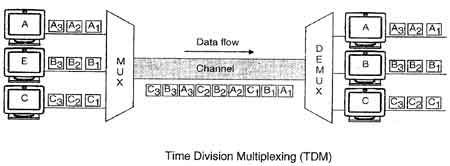
We’ll be covering the following topics in this tutorial:
Types of TDM
1. Synchronous TDM
2. Asynchronous TDM
Synchronous TDM (STDM)
1. In synchronous TDM, each device is given same time slot to transmit the data over the link, irrespective of the fact that the device has any data to transmit or not. Hence the name Synchronous TDM. Synchronous TDM requires that the total speed of various input lines should not exceed the capacity of path.
2. Each device places its data onto the link when its time slot arrives i.e. each device is given the possession of line turn by turn.
3. If any device does not have data to send then its time slot remains empty.
4. The various time slots are organized into frames and each frame consists of one or more time slots dedicated to each sending device.
5. If there are n sending devices, there will be n slots in frame i.e. one slot for each device.
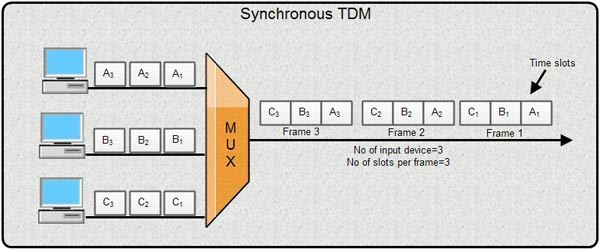
6. As show in fig, there are 3 input devices, so there are 3 slots in each frame.
Multiplexing Process in STDM
1. In STDM every device is given the opportunity to transmit a specific amount of data onto the link.
2. Each device gets its turn in fixed order and for fixed amount of time. This process is known as interleaving.
3. We can say that the operation of STDM is similar to that of a fast interleaved switch. The switch opens in front of a device; the device gets a chance to place the data onto the link.
4. Such an interleaving may be done on the basis of a hit, a byte or by any other data unit.
5. In STDM, the interleaved units are of same size i.e. if one device sends a byte, other will also send a byte and so on.
6. As shown in the fig. interleaving is done by a character (one byte). Each frame consists of four slots as there are four input devices. The slots of some devices go empty if they do not have any data to send.
7. At the receiver, demultiplexer decomposes each frame by extracting each character in turn. As a character is removed from frame, it is passed to the appropriate receiving device.
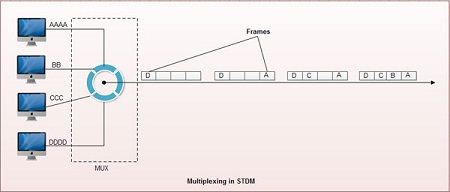
Disadvantages of Synchronous TDM
1. The channel capacity cannot be fully utilized. Some of the slots go empty in certain frames. As shown in fig only first two frames are completely filled. The last three frames have 6 empty slot. It means out of 20 slots in all, 6 slots are empty. This wastes the l/4th capacity of links.
2. The capacity of single communication line that is used to carry the various transmission should be greater than the total speed of input lines.
Asynchronous TDM
1. It is also known as statistical time division multiplexing.
2. Asynchronous TDM is called so because is this type of multiplexing, time slots are not fixed i.e. the slots are flexible.
3. Here, the total speed of input lines can be greater than the capacity of the path.
4. In synchronous TDM, if we have n input lines then there are n slots in one frame. But in asynchronous it is not so.
5. In asynchronous TDM, if we have n input lines then the frame contains not more than m slots, with m less than n (m < n).
6. In asynchronous TDM, the number of time slots in a frame is based on a statistical analysis of number of input lines.
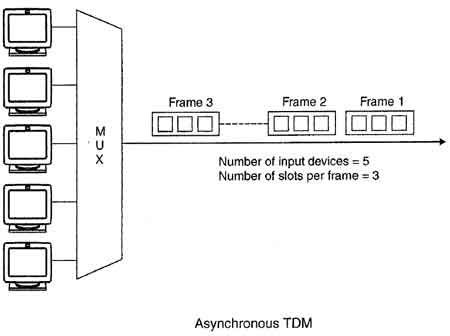
7. In this system slots are not predefined, the slots are allocated to any of the device that has data to send.
8. The multiplexer scans the various input lines, accepts the data from the lines that have data to send, fills the frame and then sends the frame across the link.
9. If there are not enough data to fill all the slots in a frame, then the frames are transmitted partially filled.
10. Asynchronous Time Division Multiplexing is depicted in fig. Here we have five input lines and three slots per frame.
11. In Case 1, only three out of five input lines place data onto the link i.e. number of input lines and number of slots per frame are same.
12. In Case 2, four out of five input lines are active. Here number of input line is one more than the number of slots per frame.
13. In Case 3, all five input lines are active.
In all these cases, multiplexer scans the various lines in order and fills the frames and transmits them across the channel.
The distribution of various slots in the frames is not symmetrical. In case 2, device 1 occupies first slot in first frame, second slot in second frame and third slot in third frame.
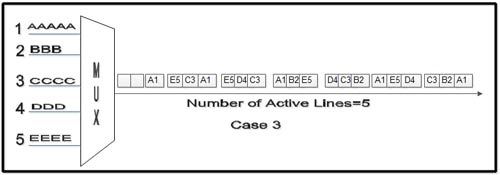
Advantages of TDM :
1. Full available channel bandwidth can be utilized for each channel.
2. lntermodulation distortion is absent.
3. TDM circuitry is not very complex.
4. The problem of crosstalk is not severe.
Disadvantages of TDM :
1. Synchronization is essential for proper operation.
2. Due to slow narrow band fading, all the TDM channels may get wiped out.
 Dinesh Thakur holds an B.C.A, MCDBA, MCSD certifications. Dinesh authors the hugely popular
Dinesh Thakur holds an B.C.A, MCDBA, MCSD certifications. Dinesh authors the hugely popular